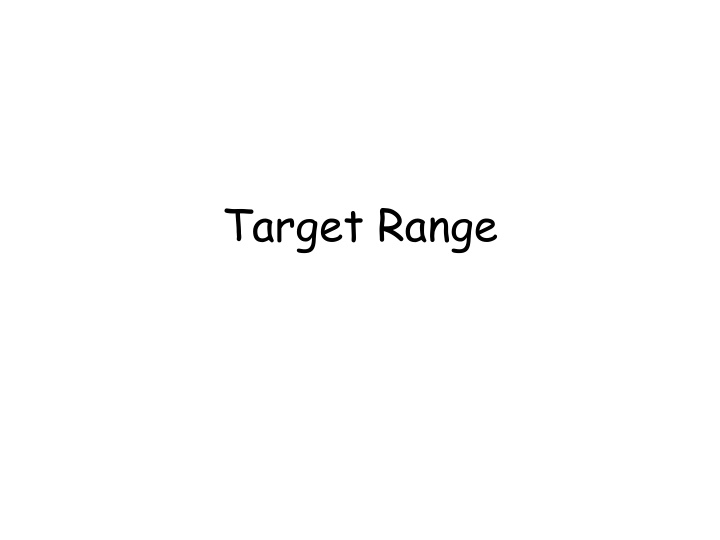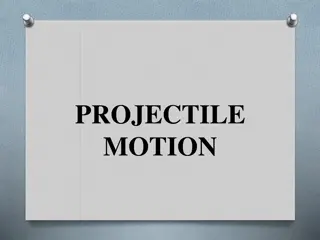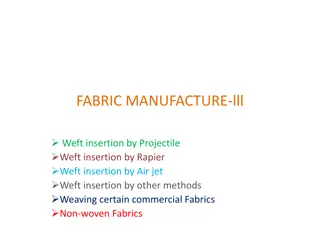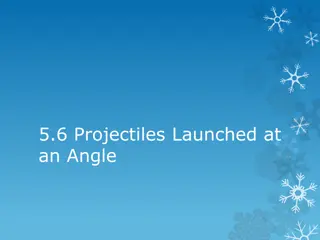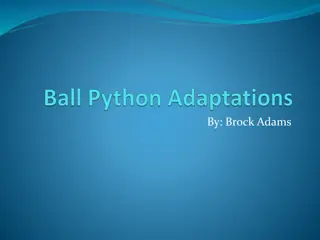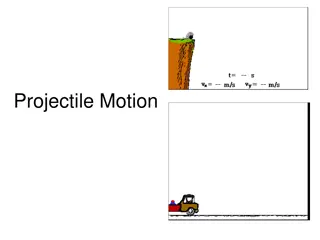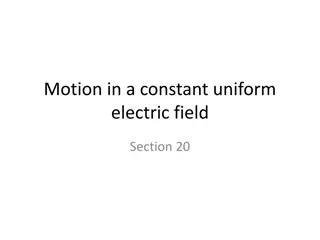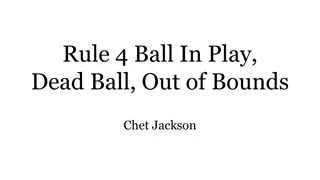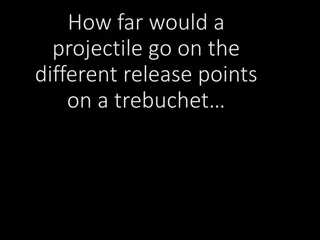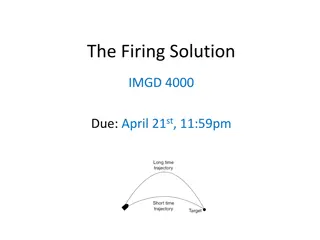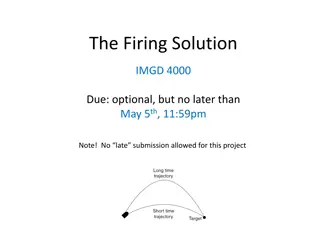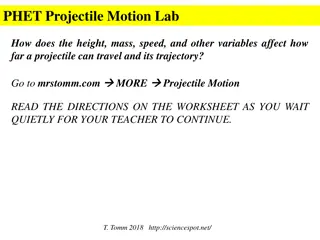Cannon Ball Projectile Range and Trajectory Analysis
Analysis of a cannon ball fired through two points to determine its range, angle of projection, and initial velocity. The trajectory is modeled as a parabola with calculations based on the given data points. Energy considerations are used to determine the velocity at the top of the flight. The angle of elevation for a range of 1000m is found to be 45 degrees.
Download Presentation

Please find below an Image/Link to download the presentation.
The content on the website is provided AS IS for your information and personal use only. It may not be sold, licensed, or shared on other websites without obtaining consent from the author.If you encounter any issues during the download, it is possible that the publisher has removed the file from their server.
You are allowed to download the files provided on this website for personal or commercial use, subject to the condition that they are used lawfully. All files are the property of their respective owners.
The content on the website is provided AS IS for your information and personal use only. It may not be sold, licensed, or shared on other websites without obtaining consent from the author.
E N D
Presentation Transcript
Target Range A cannon ball is fired and passes through the two points shown. What is the range of the cannon ball? ? = 10 ?? 2 260,192.4 850,127.5 (not to scale: all distances in metres) What s the angle of projection? What s the initial velocity?
Target Range A cannon ball is fired and passes through the two points shown. What is the range of the cannon ball? ? = 10 ?? 2 260,192.4 850,127.5 (not to scale: all distances in metres) What s the angle of projection? What s the initial velocity?
Target Range A cannon ball is fired and passes through the two points shown. What is the range of the cannon ball? ? = 10 ?? 2 260,192.4 850,127.5 (not to scale: all distances in metres) What s the angle of projection? What s the initial velocity?
Target Range A cannon ball is fired and passes through the two points shown. What is the range of the cannon ball? ? = 10 ?? 2 260,192.4 850,127.5 (not to scale: all distances in metres) What s the angle of projection? What s the initial velocity?
Target Range The trajectory is a parabola so you can fit one to the data. ? = 10 ?? 2 260,192.4 850,127.5 (not to scale: all distances in metres)
Target Range The trajectory is a parabola so you can fit one to it. ? 260,192.4 850,127.5 ? 0,0 implies ? = 0 ? = ??2+ ?? + ? 192.4 = ? 2602+ ? 260 127.5 = ? 8502+ ? 850 (1) (2) 163540 = 57460000? + 221000? 33150 = 187850000? + 221000? (1)x850 (2)x260
Target Range 163540 = 57460000? + 221000? 33150 = 187850000? + 221000? (1)x850 (2)x260 130390 = 130390000? 1 ? = 163540 = 57460 + 221000? 1000 ? = 1 ?2 1000+ ? ? = ?? ??= 2? 1000+ 1 ? = 0 ? = 0 ?? ? = 1000 ?? ??= 1 at ? = 0 angle of elevation = 45 (tan? = 1) Range is 1000 m.
Target Range Velocity can be determined from energy considerations. At top of flight the kinetic energy in the vertical direction is zero. Maximum height occurs at ? = 500(from symmetry). Maximum height = 5002 1000 Falling under gravity from that height to the ground all potential energy is converted to kinetic energy so: ?? =1 + 500 = 250m 2???2 ??2= 2 10 250 = 5000 ??= 10 50 Muzzle velocity, ? = ?? 2 = 10 100 = 100 Muzzle velocity = 100 ms-1
Target Range Alternatively, separating vertical and horizontal components of motion we have (with usual terminology): ? = ?sin?? 1 2??2 ? = ?cos? ? ? ? cos ? ? = ??2 2?2???2? (eliminating?) ? = ?tan? ? = ?tan? ??2 2?21 + ???2? Comparing the above to: ?2 1000+ ?yieldstan? = 1and? = 100, as before. ? =
Note to Teacher There is a sound effect on slide 3.
Target Range A cannon ball is fired and passes through the two points shown. What is the range of the cannon ball? ? = 10 ?? 2 (180,147.6) (870,113.1) (not to scale: all distances in metres) What s the angle of projection? What s the muzzle velocity? A SIC_33
Target Range A cannon ball is fired and passes through the two points shown. What is the range of the cannon ball? ? = 10 ?? 2 (210,165.9) (890,97.9) (not to scale: all distances in metres) What s the angle of projection? What s the muzzle velocity? B SIC_33
Target Range A cannon ball is fired and passes through the two points shown. What is the range of the cannon ball? ? = 10 ?? 2 (220,171.6) (860,120.4) (not to scale: all distances in metres) What s the angle of projection? What s the muzzle velocity? C SIC_33
Target Range A cannon ball is fired and passes through the two points shown. What is the range of the cannon ball? ? = 10 ?? 2 (230,177.1) (910,81.9) (not to scale: all distances in metres) What s the angle of projection? What s the muzzle velocity? D SIC_33
Target Range A cannon ball is fired and passes through the two points shown. What is the range of the cannon ball? ? = 10 ?? 2 (240,182.4) (840,134.4) (not to scale: all distances in metres) What s the angle of projection? What s the muzzle velocity? E SIC_33
Target Range A cannon ball is fired and passes through the two points shown. What is the range of the cannon ball? ? = 10 ?? 2 (250,187.5) (830,141.1) (not to scale: all distances in metres) What s the angle of projection? What s the muzzle velocity? F SIC_33
Target Range A cannon ball is fired and passes through the two points shown. What is the range of the cannon ball? ? = 10 ?? 2 (280,201.6) (820,147.6) (not to scale: all distances in metres) What s the angle of projection? What s the muzzle velocity? G SIC_33
Target Range A cannon ball is fired and passes through the two points shown. What is the range of the cannon ball? ? = 10 ?? 2 (270,197.1) (810,153.9) (not to scale: all distances in metres) What s the angle of projection? What s the muzzle velocity? H SIC_33
Target Range A cannon ball is fired and passes through the two points shown. What is the range of the cannon ball? ? = 10 ?? 2 (290,205.9) (790,165.9) (not to scale: all distances in metres) What s the angle of projection? What s the muzzle velocity? I SIC_33
Target Range A cannon ball is fired and passes through the two points shown. What is the range of the cannon ball? ? = 10 ?? 2 (310,213.9) (770,177.1) (not to scale: all distances in metres) What s the angle of projection? What s the muzzle velocity? J SIC_33
Target Range A cannon ball is fired and passes through the two points shown. What is the range of the cannon ball? ? = 10 ?? 2 (320,217.6) (760,182.4) (not to scale: all distances in metres) What s the angle of projection? What s the muzzle velocity? K SIC_33
Target Range A cannon ball is fired and passes through the two points shown. What is the range of the cannon ball? ? = 10 ?? 2 (330,221.1) (750,187.5) (not to scale: all distances in metres) What s the angle of projection? What s the muzzle velocity? L SIC_33
Target Range A cannon ball is fired and passes through the two points shown. What is the range of the cannon ball? ? = 10 ?? 2 (340,224.4) (740,192.4) (not to scale: all distances in metres) What s the angle of projection? What s the muzzle velocity? M SIC_33
Target Range A cannon ball is fired and passes through the two points shown. What is the range of the cannon ball? ? = 10 ?? 2 (350,227.5) (730,197.1) (not to scale: all distances in metres) What s the angle of projection? What s the muzzle velocity? N SIC_33
Target Range A cannon ball is fired and passes through the two points shown. What is the range of the cannon ball? ? = 10 ?? 2 (360,230.4) (720,201.6) (not to scale: all distances in metres) What s the angle of projection? What s the muzzle velocity? O SIC_33
Target Range A cannon ball is fired and passes through the two points shown. What is the range of the cannon ball? ? = 10 ?? 2 (370,233.1) (710,205.9) (not to scale: all distances in metres) What s the angle of projection? What s the muzzle velocity? P SIC_33
